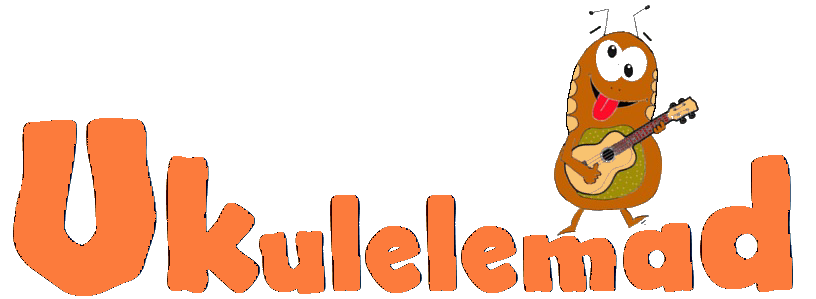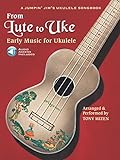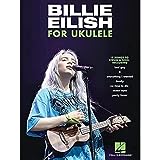Ukulele Parts
Notes on the Ukulele fretboard
The diagram shows the Ukulele fretboard notes for the standard ukulele tuning G C E A. This layout is the same for Soprano, Concert and Tenor size Ukuleles. All the note and their positions can be clearly seen for one octave. The same pattern repeats for the second octave starting at fret 12.

Ukulele parts
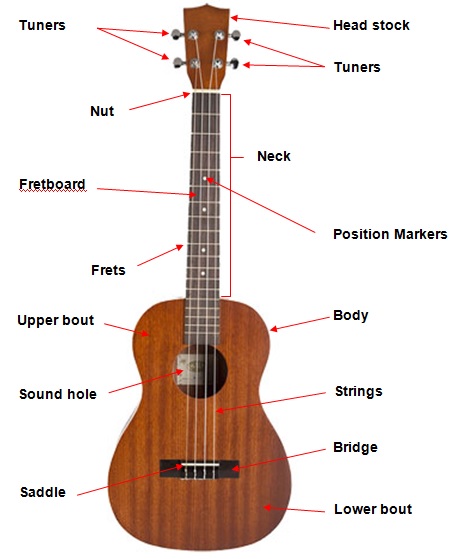
Body:
The body consists of a back, top and sides. The type of wood the body is made from can make a big difference in sound. Some woods produce a harsh sound and others more mellow. More expensive ukuleles are often made of solid wood as opposed to laminate. Body shapes can vary with guitar and pineapple shapes being most common.
Bout:
A bout is the bulge or widening of an instrument such as a guitar or ukulele. The narrow part between the upper and lower bouts is known as the waist or middle bout.
Bridge:
The bridge is mounted on the top of the body below the sound hole. The bridge holds the strings at one end and transfers their vibration to the sound board or other amplifying surface. The bridge also holds the saddle.
Fret Markers:
Fret markers, also called fretboard inlays are usually round dots on the fretboard, although on expensive instruments these can be very ornate. On a ukulele the markers are usually positioned at the third, fifth, seventh, tenth and twelfth frets and are a visual aid to help you easily find the notes or chords you wish to play. Some instruments also have markers along the side of the neck. The twelfth fret often has two dots marking the octave. The note played at the twelfth fret is always the same as the note played on the open string but one octave higher.
Fretboard:
The fretboard, sometimes called the fingreboard is a thin strip of material usually hardwood such as ebony, maple or rosewood etc, laminated to the neck of the instrument. The fretboard may be fretted, having raised fret wires made of hard material like nickel silver perpendicular to the strings.
Frets:
Frets are the raised elements that extend across the width of the neck. They are often made of metal such as nickel silver. Pressing a string against a fret changes the vibrating length of that string in turn changing it's pitch and the note being played.
Headstock:
The headstock is the widened piece at the end of the ukulele neck. It's main function is to hold the tuners. Manufacturers will often position their logo on the headstock.
Neck:
The neck is a sturdy piece of wood that projects from the ukulele body and supports the fretboard. The headstock is at the top end of the neck.
Nut:
The nut is a small piece of hard material such as plastic or bone mounted at the headstock end of the fretboard. It keeps the strings evenly spaced and at the correct height above the frets.
Saddle:
The saddle is a small strip of hard material fitted to the bridge that keeps the strings at the correct height above the fretboard.
Standard tuning relative to keyboard
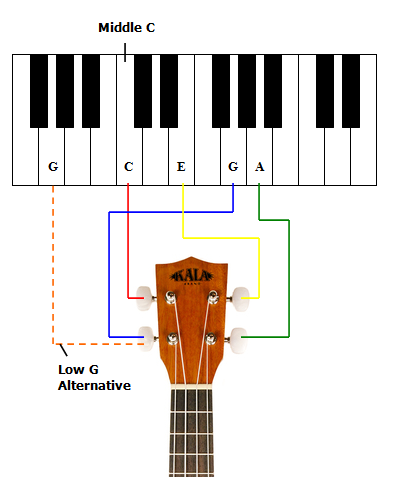
Sound Hole:
The sound hole is an opening in the top of the body. Sound holes can vary in shape, but the most common is a round hole under the strings. F - holes are also commonplace and usually seen in pairs placed on both sides of the strings.
Strings:
The strings run from the bridge to the tuning pegs and are the part of the instrument you pick or strum to make the sound produced by your ukulele. Strings can be plain or wound and are usually made of material such as steel or nylon or a combination of both. A wound string could have a solid nylon core with a steel winding along it's length.
Tuners:
Also referred to as tuning pegs, tuning keys, machine heads and many other names. Mounted on the headstock the tuners hold the strings and allow the instrument to be tuned. Turning the tuners clockwise or anticlockwise adjusts the tension of the string which in turn alters the pitch played thereby tuning it.
